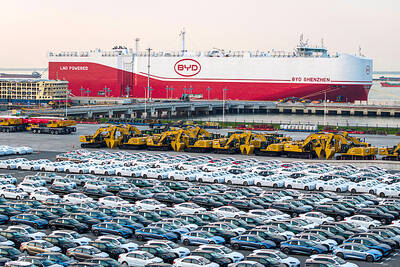Semiconductor Manufacturing International Corp (SMIC, 中芯) vice chairman Chiang Shang-yi (蔣尚義) has resigned less than a year after joining the company, China’s biggest chipmaker said on Thursday.
It is the second departure of a senior executive at the Shanghai-based firm in two months.
Chiang, who is in his mid-70s, has left SMIC to spend more time with his family, the company said in a filing.
The chip industry veteran joined SMIC in December last year, after having helped to turn Taiwan Semiconductor Manufacturing Co (TSMC, 台積電) into the world’s most influential contract chip manufacturer more than a decade ago.
SMIC shares dropped as much as 4.5 percent in Hong Kong yesterday.
Alongside Chiang’s departure, SMIC also reported that revenue climbed 31 percent to US$1.42 billion in the third quarter this year, compared with the US$1.39 billion average of analysts’ forecast.
Profit was US$321.4 million in the same period, the company said in a separate filing, also beating estimates.
The resignation marks the latest management upheaval at SMIC, which is considered Beijing’s best hope at making advanced chips to counter sanctions by the US.
In September, SMIC chairman Zhou Zixue (周子學) stepped down for health reasons, while cochief executive officer Liang Mong-song (梁孟松) threatened to quit late last year after learning that Chiang would join as vice chairman.
Liang and Chiang are among the sector’s top developers, but stand for different technology paths.
Liang later stayed after rounds of negotiations.
He is stepping down as an executive director, but would continue to serve as cochief executive officer, SMIC said.
Before joining the chipmaker, Chiang ran Wuhan-based Hongxin Semiconductor Manufacturing Co (武漢弘芯), a Chinese government-backed chipmaker.
He left after the company ran into funding troubles.
To satisfy China’s demand for home-made chips, SMIC has been expanding its capacity with a new US$8.87 billion plant in Shanghai, as well as a US$2.35 billion factory in Shenzhen.
It is the most capable chipmaker in China in terms of capacity and technical know-how, but the company has been unable to buy key machinery from overseas suppliers including ASML Holding NV after it was blacklisted by the administration of former US president Donald Trump.
SMIC is working hard to resolve shortages, executives said on a conference call on Friday.
Some license approvals have been delayed, but the company is making sure expansions are on schedule, they said.
The company is trying to accelerate the licensing approval process so it can have equipment for output expansion, which would triple its capacity in the coming years, SMIC cochief executive officer Zhao Haijun (趙海軍) added.
“We will make every effort to work with suppliers to speed up procurement, delivery,” Zhao said.
Revenue for the fourth quarter would increase 11 to 13 percent from the previous three months, with gross margin of as much as 35 percent, the chipmaker said.
It boosted its full-year sales growth target to about 39 percent, or 29 percent based on Chinese accounting standards.
Demand would continue to outpace supply throughout next year, and the company expects to grow no less than the industry average, Zhao said.

GROWING OWINGS: While Luxembourg and China swapped the top three spots, the US continued to be the largest exposure for Taiwan for the 41st consecutive quarter The US remained the largest debtor nation to Taiwan’s banking sector for the 41st consecutive quarter at the end of September, after local banks’ exposure to the US market rose more than 2 percent from three months earlier, the central bank said. Exposure to the US increased to US$198.896 billion, up US$4.026 billion, or 2.07 percent, from US$194.87 billion in the previous quarter, data released by the central bank showed on Friday. Of the increase, about US$1.4 billion came from banks’ investments in securitized products and interbank loans in the US, while another US$2.6 billion stemmed from trust assets, including mutual funds,

Micron Memory Taiwan Co (台灣美光), a subsidiary of US memorychip maker Micron Technology Inc, has been granted a NT$4.7 billion (US$149.5 million) subsidy under the Ministry of Economic Affairs A+ Corporate Innovation and R&D Enhancement program, the ministry said yesterday. The US memorychip maker’s program aims to back the development of high-performance and high-bandwidth memory chips with a total budget of NT$11.75 billion, the ministry said. Aside from the government funding, Micron is to inject the remaining investment of NT$7.06 billion as the company applied to participate the government’s Global Innovation Partnership Program to deepen technology cooperation, a ministry official told the

Taiwan Semiconductor Manufacturing Co (TSMC, 台積電), the world’s leading advanced chipmaker, officially began volume production of its 2-nanometer chips in the fourth quarter of this year, according to a recent update on the company’s Web site. The low-key announcement confirms that TSMC, the go-to chipmaker for artificial intelligence (AI) hardware providers Nvidia Corp and iPhone maker Apple Inc, met its original roadmap for the next-generation technology. Production is currently centered at Fab 22 in Kaohsiung, utilizing the company’s first-generation nanosheet transistor technology. The new architecture achieves “full-node strides in performance and power consumption,” TSMC said. The company described the 2nm process as

POTENTIAL demand: Tesla’s chance of reclaiming its leadership in EVs seems uncertain, but breakthrough in full self-driving could help boost sales, an analyst said Chinese auto giant BYD Co (比亞迪) is poised to surpass Tesla Inc as the world’s biggest electric vehicle (EV) company in annual sales. The two groups are expected to soon publish their final figures for this year, and based on sales data so far this year, there is almost no chance the US company led by CEO Elon Musk would retain its leadership position. As of the end of last month, BYD, which also produces hybrid vehicles, had sold 2.07 million EVs. Tesla, for its part, had sold 1.22 million by the end of September. Tesla’s September figures included a one-time boost in